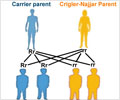Some 1.5 to 2 million Americans are infected with the hepatitis B virus (HBV), according to the Centers for Disease Control and Prevention (CDC).
Some 1.5 to 2 million Americans are infected with the hepatitis B virus (HBV), according to the Centers for Disease Control and Prevention (CDC).
Prior studies have shown there to be significant racial differences in access to and outcomes of liver transplantation. Recently, doctors from across the U.S. conducted a multicenter retrospective-prospective study of the waitlist status and outcomes of liver transplant patients with HBV infection. This study led by Natalie Bzowej from California Pacific Medical Center and Anna Lok from the University of Michigan and funded by a grant from the National Institutes of Health (NIH), found there to be similar waitlist and post-transplant outcomes among Asian Americans, African Americans, and Caucasians with HBV. These research findings appear in the September issue of Liver Transplantation, a journal of the American Association for the Study of Liver Diseases, published by Wiley-Blackwell.The NIH HBV liver transplant study had a total of 274 patients (116 Caucasians, 135 Asians and 23 African Americans) enrolled in 15 centers across the U.S. Participants were placed on the United Network of Organ Sharing (UNOS) liver transplantation recipient waitlist between 1996-2005. The probability of transplantation 1, 3 and 5 years after listing was 53%, 75%, and 88% for African Americans; 48%, 58% and 66% for Asian Americans; and 48%, 57% and 63% for Caucasians. "As expected, the interval between listing and transplantation was shortest for patients with acute liver failure, followed by those with hepatocelluler carcinoma (HCC), and those with endstage cirrhosis. Our research showed transplant indication and Model for End-stage Liver Disease (MELD) score for endstage cirrhosis patients were the only predictors of transplantation, but race was not," said researchers.
Of the total number of study participants, 170 received transplantations between 2001and 2007. The probability of post-transplant survival at 5 years was 94% for African Americans, 85% for Asian Americans, and 89% for Caucasians. "Analysis indicated that HCC recurrence was the only predictor of post-transplant mortality while race, indication for transplant, and HBV recurrence were not," the authors explained.
According to the research, Caucasians had a higher rate of HBV recurrence with the 4-year recurrence rate at 19% compared to 7% and 6% for Asian Americans and African Americans, respectively. "We found that hepatitis B e antigen (HBeAg) status at listing was the only factor significantly associated with HBV recurrence post-transplant, while race showed a trend," said Dr. Bzowej. "Our findings of a higher rate of HBV recurrence among Caucasians needs to be validated in other studies," she added.
Charles D. Howell, MD, Professor of Medicine, The University of Maryland School of Medicine, commented on the NIH HBV liver transplant study in his editorial also published in the September issue of Liver Transplantation. Dr. Howell cited earlier studies where outcomes across the races were varied. "The study of the Organ Procurement and Transplantation Network (OPTN) data from 1994-1998 (Reid et al) found that African Americans 18-70 were under-represented on the UNOS liver recipient waiting list. A 2008 study showed African American patients transplanted between 2002 and 2006 experienced lower survival rates than Caucasians," he noted.
Results from NIH HBV liver transplant study indicate similar waitlist and post-transplant outcomes across the three racial groups studied. "More study is necessary to determine whether the disparity between African Americans, Asians, and Caucasians in outcomes of liver transplantation for HBV persists in the most recent era," concluded Dr. Howell.
Advertisement
Source-Eurekalert
RAS















